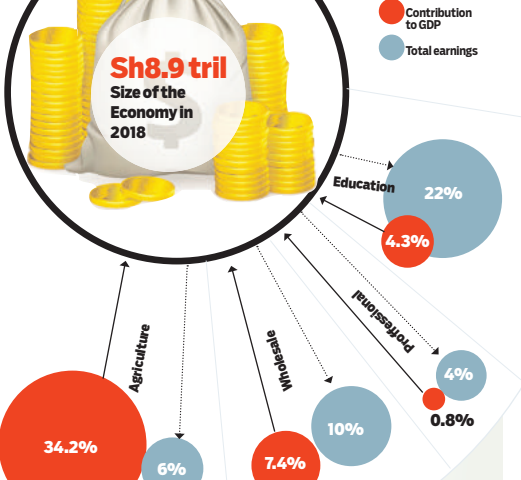
Kenya’s economy gifted intermediary companies and individuals super profits, but the producers got peanuts for their labour, going by the analysis of the 2019 Economic Survey.
At the same time, foreigners engaged in commercial crop production had a boon even as small scale farmers were forced to sell their produce at throw-away prices despite high production costs.
Workers in plantations were also hard hit as they were paid poorly by employers who were keen to minimise costs and maximise profits.
The figures released by the National Bureau of Statistics (KNBS) on Thursday show that despite helping the country to generate products valued at Sh1.15 trillion last year, majority of Kenyans working on the farms received meagre wages compared to their peers in the other sectors.
This is happening even as other reports showed that there were loss-making companies, with some being forced to offload workers to stay afloat.
Huge variance
The 6.3 per cent super-growth has been dismissed by some experts who argue that it has not been felt by majority of Kenyans.
In what is perhaps the most glaring reason why majority of Kenyans are not feeling the 6.3 per cent growth, the economy seemed to reward a few individuals but the 336,000 employees in the expansive agricultural sector who together contributed to a third, Sh3.3 trillion, of the economy.
However, they shared themselves compensation fees of Sh115 billion.
Of the Sh3.3 trillion produced by the sector that is also a key foreign exchange earner through such produce as tea and flowers, Sh2.7 trillion went to owners of capital such as milk processors, tea factories, sugar and maize millers.
While most of these profits might have gone to farmers themselves since most of the country’s agriculture is subsistence, the huge variance between farm gate prices paid to farmers for their produce and the final price paid by consumer for the final product shows that middle-men rather than farmers were the biggest beneficiaries.
Last year, for example, milk processors paid dairy farmers Sh35 for a litre of raw milk they collected, according to figures provided by the national statistician. However, after the same milk had been processed -- with products such ghee and butter having been extracted and sold separately -- it was offered to consumers at Sh130.
Timothy Njagi, a research fellow at Tegemeo Institute of Agricultural Policy and Development, a public think-tank affiliated to Egerton University, argued that the Sh95 difference between the farm-gate price and consumer price is too much for transportation and processing. Pasteurisation -- the process through which milk is sterilized for consumption -- is basically just “heating,” according to Njagi, an agricultural economist.
“If there are inefficiencies in processing, we need to know what those inefficiencies are,” he said, noting that for the better part of 2018, farm-gate prices of milk were being revised downwards even as consumer prices went up.
Stay informed. Subscribe to our newsletter
It was also not a good year for maize farmers, though production of the cereal impressively increased to 44.6 million bags from 35.4 million bags in the previous year. The result was that prices paid to farmers declined by 14 per cent to Sh49 for a kilogramme from Sh57 in 2017, as brokers had a field day.
“Prices for almost all commodities went down big-time,” Njagi said. “Even if you produce more and prices go down by a big margin, you will not benefit.”
Bags of maize were rotting in silos as some farmers disposed of their harvests at a loss. Furious farmers expressed disappointment over the pitfalls of maize farming at a recent Senate Committee sitting in Eldoret town, Uasin Gishu County. “We are in big trouble. There is maize in the stores, there is maize at NCPB stores, and there is maize that awaits harvesting,” said one farmer.
Inflated price
Scholastica Odhiambo, an Economics lecturer from Maseno University said that except for maize, other farmers have been left to the whims of cartels who buy their produce at low prices and sell it at inflated price.
“Our agricultural policy has not been favourable to farmers,” she said, noting that a lot of farmers do not even pay themselves.
“The only way to help farmers is to help incentive for value-addition.”
Agricultural workers -- some of whom like those in tea plantations have engaged owners in a spirited fight for better working conditions -- also had it rough in 2018, compared to their peers in other sectors.
Fewer of them were pensionable and unionized, making it hard for them to bargain for better employment terms.
Earnings from export of flowers were decent, earning the country foreign exchange, but they did not wipe the tears of several flower-farm workers who have complained of poor working conditions.
Moreover, most of the flower farms, according to an analysis by Saturday Standard, are foreign-owned, a situation that exposes the country to capital flight.
In 2018, for example, collective bargaining agreements (CBAs) reached by agricultural workers were only three, six-times less than the 18 that were reached in 2017. Only in Electricity, Gas, Steam and Air Conditioning Supply were CBAs reached less.
The number of unionisable employees declined dramatically by 161 per cent from 3,211 to 1,227.
Generally, the number of unionised workers declined 11.8 per cent from 94,792 in a year that also saw a decline in formal jobs. Ms Odhiambo noted that generally, agricultural workers are employed in plantations in rural areas where minimum wages are low due to poor skills unlike their counterparts in manufacturing sector who are highly skilled.
 The Standard Group Plc is a
multi-media organization with investments in media platforms spanning newspaper
print operations, television, radio broadcasting, digital and online services. The
Standard Group is recognized as a leading multi-media house in Kenya with a key
influence in matters of national and international interest.
The Standard Group Plc is a
multi-media organization with investments in media platforms spanning newspaper
print operations, television, radio broadcasting, digital and online services. The
Standard Group is recognized as a leading multi-media house in Kenya with a key
influence in matters of national and international interest.
 The Standard Group Plc is a
multi-media organization with investments in media platforms spanning newspaper
print operations, television, radio broadcasting, digital and online services. The
Standard Group is recognized as a leading multi-media house in Kenya with a key
influence in matters of national and international interest.
The Standard Group Plc is a
multi-media organization with investments in media platforms spanning newspaper
print operations, television, radio broadcasting, digital and online services. The
Standard Group is recognized as a leading multi-media house in Kenya with a key
influence in matters of national and international interest.









